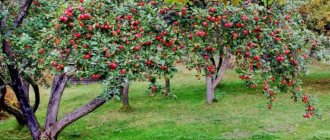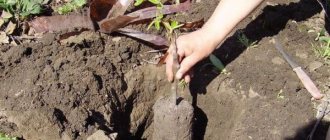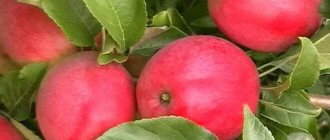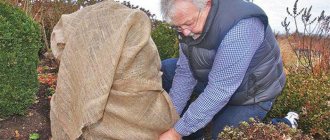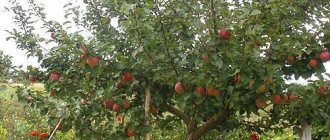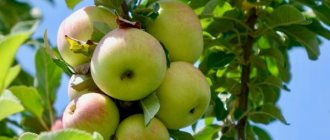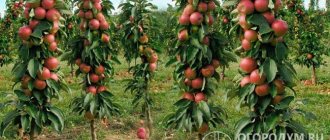Description
Photo of the Niedzwiecki apple tree and its fruits.
When grown in park culture, the Niedzwiecki apple tree grows as a tree up to 8 meters tall.
All parts of the plant are colored by anthocyanins . Hence the intense purple color not only of the fruits - the bark, leaf petioles, and buds are also purple. Even the wood has a pink tint.
Depending on the place of growth, flowering occurs in the second half of May - early June. itself lasts about 10 days , but together with the phase of unopened buds (quite long), this period extends for almost a month.
Attention! The Niedzwiecki apple tree is grown as a tree or bush. Using cutting techniques, you can realize any designer’s ideas. Wood is a very plastic artistic material .
This decorative tree not only decorates the garden composition during flowering, but also attracts bees to the garden during flowering and birds in winter .
The decorative Niedzvetsky apple tree perfectly decorates parks and squares.
Pros and cons of the variety
Now let's look at the positive and negative sides of the plant.
According to the description, photos and reviews of gardeners, the Nedzvetsky apple tree is a fast-growing frost-resistant plant, so the area for its cultivation is becoming wider every year.
The reason for the popularity of the Niedzwiecki apple tree in landscape design, in addition to decorativeness, is also the plant’s resistance to various diseases and pests. In addition, the apple tree can easily tolerate drought, which is also important, since in many regions of Russia in summer there is a serious problem with rain.
In addition, as gardeners write in reviews, it does not require any special conditions and is unpretentious in cultivation. The decorative Niedzwiecki apple tree, a photo of which we have posted below, can be grown on any soil.
Attention! Polluted and dusty air does not have a negative impact on the development and decorativeness of the Niedzvetsky red-leaved apple tree, which is why it is planted in city parks and squares.
If we talk about disadvantages, then this variety of ornamental apple tree probably has only one: it is affected by scab.
additional characteristics
Peculiarities
Niedzwiecki's apple tree is a medium-sized tree (3-5 meters) with an almost spherical crown:
- The purple-colored trunk is covered with bark that is prone to cracking.
- The tree blooms at the end of May - beginning of June. Flowering duration is approximately 2 weeks. Usually it blooms for the first time at the age of 5, but practically does not set fruit until 10 years.
- Small apples ripen in August (pink inside, dark red skin).
- The variety is self-sterile, but this drawback is compensated by the fact that almost any apple tree in the area can pollinate this beauty with large crimson flowers.
Phenological type
The Niedzvetsky apple tree has a pronounced decorative effect .
Each season has a characteristic color scheme:
- Spring - green and purple foliage interspersed with large carmine-pink (sometimes crimson) flowers,
- Summer - foliage darkens to purple, dark red apples appear,
- Autumn - leaves are crimson-yellow, almost purple apples,
- Winter - dark purple branches are densely strewn with almost purple apples at the beginning of winter.
Latin name
The Latin name of the plant “Malus” comes from the Greek “malon, melon” (translated as apple).
At the end of the 19th century, the botanist Niedzvetsky collected wild apple fruits from the spurs of the Tien Shan and sent them to the German doctor of biology Dick. These tiny apples gave rise to the rapidly spreading ornamental Niedzwiecki apple tree - Malus niedzwetzkyana Dieck.
Tree height
Trees taller than 6-8 m are rarely found in park culture.
This may be due to formative pruning , but in the wild (and the plant is already almost listed in the Red Book!) there are specimens 10-12 meters long.
Crown width
Decorative apple tree in garden design.
Initially, at the beginning of the tree’s life, the crown of this variety develops like a “pyramid”, but during the process of growth, under the weight of foliage and fruits, the branches sag - the crown becomes spherical .
The overall dimensions of the tree are about 6 meters.
Annual growth
This apple tree is a tree of medium growth , which usually reaches 3 meters in height at the age of 13.
Dark purple growth shoots usually grow 40-60 centimeters per year.
Evaluation of fruit taste
The fruits of the Niedzwiecki apple tree are not much larger than cherries - usually their diameter does not exceed 3 centimeters.
But under the influence of the rootstock and favorable conditions, a harvest of small apples with a diameter of up to 4 centimeters is possible.
Of course, apples are edible . Their taste differs little from the wild forest apple tree traditional for our region - just as tart. However, after frost they become much tastier (under the influence of frost, the bitterness of viburnum and rowan berries decomposes).
Important! The fruits do not fall off all winter and are an excellent food for wintering birds.
Sheet type
This ornamental apple tree has elliptical leaves with a jagged edge , tapering to a wedge-shaped tip and base.
In spring and early summer, these leathery leaves, pubescent on the reverse side, are reddish-brown in color.
Then they darken and acquire a purple tint, especially noticeable on the underside.
Winter hardiness
Accustomed to the harsh conditions of the Tien Shan, the Nedzvetsky apple tree easily withstands winter temperatures down to -30 degrees
Disease resistance
Like all wild trees, the ornamental Niedzwiecki apple tree is practically immune to common apple tree diseases.
In addition, it is not very demanding on the composition of the soil and even tolerates saline soils .
The culture may be favored by aphid colonies.
Possible damage from mites, weevils, glass insects, and scale insects.
The plant is an ornamental plant - treated with chemicals as needed.
Lifespan of a tree
There are known wild trees over 60 years old. Cultivation in favorable conditions contributes to a longer life of the tree.
History of the variety
The variety is named after the famous botanist Nedzvetsky, who collected the fruits of this tree in the vicinity of Kashkar.
The homeland of this beautiful variety is Asia, from where it spread to Europe and North America. According to archaeological data, the Niedzwiecki apple tree has existed for thousands of years, and today this variety has several types that differ in their crown, the color of the leaves and apples. Most of the species of this variety are obtained naturally, through pollination and adaptation to different climatic conditions.
Currently, a large number of apple trees grow throughout the Russian Federation, which were bred using the Nedzvetsky variety. Wild species of this variety are often used to decorate city squares and parks.
Reviews
Various forums are full of reviews from lovers of garden design and more.
Nikolay, Tver region, 52 years old. I became interested in vaccinations. I learned from YouTube. It turned out - nothing supernatural. I trained in my own garden, instilled in everything. Now I graft not only fruit trees.
A couple of years ago I brought cuttings of an ornamental apple tree. After I found the description and photo, I grafted it into the crown of an ordinary ranetka near the house. You can’t get enough of such beauty in 2 weeks of flowering...
Alexey, Leningrad region, 45 years old. We have a dacha only for outdoor recreation, exclusively flowering plants.
A friend of mine has advanced soot disease - he doesn’t miss a single seasonal fair in all the nurseries in the area. There is no place to plant it myself—he can’t miss anything interesting. The new product will not pass you by.
He gave me a gift for my 40th birthday, knowing my family’s love for flowers. He even secretly came and planted it. When the “gift” bloomed 2 years ago, I was shocked by its beauty...
Yes, I forgot to say, the “gift” has a proper name - Niedzwiecki’s apple tree.
Reviews from gardeners
Reviews from experienced gardeners about this variety are positive. These trees are mainly used for landscape design. The use of fruits in cooking allows you to prepare jams and compotes from them. You can also dry apples.
In order for the tree to grow and develop intensively, as well as to produce good yields, it must be provided with the necessary care. In this case, the Niedzwiecki apple tree will delight you with its beautiful appearance and good fruits. The price of this variety, according to reviews from gardeners, is quite acceptable.
Landing
Deadlines
Planting an apple tree.
It is known that trees can be planted in a permanent place:
- Early in the spring until the buds open;
- In autumn , when the tree enters a dormant period.
Spring planting dates are preferable for cold regions, where after planting a seedling the ground freezes quickly and the young tree does not have time to fully take root.
If the top layer of soil does not freeze before the onset of calendar winter , the seedling will form small overgrowing roots until December and will overwinter well. In early spring, the apple tree will quickly grow.
Soil preparation
For planting, you should choose a sunny place where groundwater does not come closer than 1.5-2 meters to the surface.
You must immediately take into account that the crown of an adult tree has a diameter of up to 6 meters, and after 10 years it will be almost impossible to replant the tree.
Important! The planting hole should be prepared at least 2 weeks before planting. This is not a whim at all. The earth must settle. Otherwise, after planting, it will settle along with the apple tree and the root collar will deepen below the permissible level.
For a 2-3 year old seedling, its dimensions should be at least 70x70x80 cm.
Fill the hole halfway with a mixture of compost (humus), garden soil and river sand in proportions 3:1:2.
It is advisable to add wood ash (0.5 liters).
Technology
To cope without helpers and not make a mistake with the planting depth, drive a peg into the center of the hole and tie the seedling to it with a figure of eight so that the root collar is at soil level.
Gently straighten the roots and sprinkle them with soil. Water the seedling with 2-3 buckets of water and fill the planting hole to the top with soil.
Form a circle around the trunk and, if possible, cover it with mulch.
In groups
A single planting of this variety is preferable from the point of view of a park composition - a bright spot against the background of a lawn or ordinary apple trees. You should maintain a sense of proportion and not overload the composition with these spots - too colorful does not attract the eye.
Even when using small groups, it should be remembered that apple trees retain their decorative properties only in open spaces .
Again, in free space, trees are less susceptible to fungal diseases, which will preserve the beauty of the garden for a long time.
in autumn
Like most varieties, the ornamental Niedzwiecki apple tree takes root more successfully when planted in autumn .
This is due to the fact that the roots of any trees do not have a rest period. They also grow in winter, but not so quickly.
Before the onset of real frost, the tree has time to take root. Moreover, all the forces go specifically to the growth of the root system - the upper part is asleep.
Attention! In addition, autumn planting is preferable since you will not have problems with watering.
Necessary conditions for cultivation
Before planting a tree, it is worth finding out its requirements for agricultural technology.
Climatic conditions
The ornamental Niedzwiecki apple tree is attractive to gardeners because it can easily adapt to any climatic conditions. The tree is not afraid of either dry or frosty weather.
Soil composition
The tree prefers loose and fertile soils of medium weight. It can grow safely in any area, but rocky, too dry or, conversely, waterlogged and swampy soils should be avoided. The optimal soil composition is garden soil, river sand and humus in equal proportions.
Illumination of the area
In order for a young ornamental apple tree seedling to take root easily and quickly, you need to choose open areas with an abundance of natural sunlight. They must be protected from drafts and strong gusts of wind.
Favorable and Undesirable Neighbors
The ornamental Niedzwiecki apple tree has good contact with apricots, cherries, plums and other fruit trees that bloom white. It is not advisable to plant shrubs under an apple tree, since due to the powerful root system it will hinder their growth.
Propagation by seeds, cuttings
The main method of propagation of ornamental apple trees is vegetative, by grafting onto forest and berry (“Siberian”) varieties.
This is due to the length and unpredictability of the process . One can only guess how the seedling will grow and what color its flowers will be.
Seeds should be planted in the fall to a depth of 2-3 centimeters. Perhaps it will surpass the mother plant, but this is the field of activity of breeders.
A fairly high percentage of survival rate of cuttings (46%) after treatment with heteroauxin makes it possible to adopt this method of vegetative propagation.
Decorative varieties of this tree can be successfully propagated by root shoots - separated seedlings grow quickly and begin to bloom.
Rootstock
It is recommended to graft cuttings of ornamental apple trees onto the rootstocks of wild apple trees or “Siberian” apples, a wild-growing berry variety .
Such a rootstock provides high resistance of the scion to winter frosts and other unfavorable factors, as well as fungal diseases and most pests that parasitize the fruit form of the apple tree.
Agrotechnical recommendations
According to experts and experienced gardeners, the variety is unpretentious in care and responds well to standard agricultural techniques. The plant loves well-lit areas with fertile, moist, well-drained soil that has neutral acidity. The most important things for the full development of a tree are timely, sufficient watering and regular formative pruning to maintain an aesthetic appearance.
Reproduction is carried out by seeds or by grafting, layering, cuttings (vegetatively). With the seed method, splitting of characters is often observed , so it is necessary to select seedlings with purple leaf color.
A professional gardener talks in more detail about the features of vegetative propagation of fruit trees in the following video:
Features of cultivation
Agricultural technology
Planting an apple tree.
The agricultural technology of ornamental varieties is not much different from the cultivated forms of garden trees. The only difference , which is always to the advantage of gardeners, is that this tree will always forgive you small omissions and flaws. No one expects special quality fruits, so if root feeding is not possible, leaf feeding is sufficient.
Like all forms, the Niedzwiecki apple tree variety does well in spacious areas with good ventilation.
When planting, be sure to fill the planting hole with organic matter (rotted manure or compost) half and half with a peat-sand mixture. A lack of nitrogen nutrition in the first phase of the life cycle will not allow the apple tree to acquire a decorative appearance . A stunted tree with red leaves is not at all what you dreamed of.
Advice! It is useful to mulch the tree trunk circle with peat, wood chips, and nut shells. In this form, circles also add their own touch to garden decor.
Pruning and crown formation
Pruning of ornamental apple trees is done to maintain a healthy (and therefore decorative) appearance of the apple tree.
The standard operations for annual autumn (spring) garden pruning are the same:
- Remove dried and broken branches,
- All growing incorrectly (inside the crown, thickening),
- Trim the tips of the branches to improve growth by 1/3-1/4 of the length.
After 10 years of cultivation, rejuvenating pruning should be carried out to restore the active growth of young branches with flower buds.
What can be vaccinated?
Considering the decorative nature of the variety, the crown of this apple tree is most often grafted with related ranetki or wild apple trees for an original design of the crown with branches of different colors.
There are no restrictions regarding scions , especially since the grafted variety will pollinate the Niedzwiecki apple tree itself.
Pollinator varieties
The Niedzwiecki apple tree is a monoecious plant; a pollinator is required for the formation of ovaries .
Fortunately, she is very unpretentious in this regard. The flowers of the ornamental apple tree are pollinated with pollen from any apple tree .
Considering that apple trees grow everywhere, bees successfully cope with this task.
Features of ripening and fruiting
Bloom
Period
The Niedzwiecki apple tree blooms immediately after the leaves bloom, at the end of May .
Lasts from 10 days to 2 weeks, it depends on the variety of ornamental apple tree.
The flowering time may shift depending on the region where the apple tree grows, soil conditions, the location of the tree relative to buildings and the terrain.
Reasons for absence
Sadly, a purely ornamental tree may not bloom .
This can happen if:
- The tree is younger than 5-6 years old (be patient for a year or two),
- Too fertile soil (excess nitrogen) - the tree “fattens”, only false growth shoots grow (heavy pruning and potassium-phosphorus fertilizing can provoke the formation of flower buds).
- A possible reason may be damage to flower buds by return frosts if the planting site is poorly chosen. For example, a wave of frosty air descends into a lowland.
- The tree is sick due to damage (frost damage, rodents).
Use of fruits
The fruits of the ornamental apple tree are used mainly for drying , since the entire complex of vitamins and microelements is preserved in this form.
Small fruits are well suited for processing into marshmallows, jam and cider .
Traditional medicine also did not ignore the use of wild forms of apple trees (including Nedzvetsky) in medicinal practice.
Can it be eaten?
Fruits of the ornamental apple tree.
The fruits of the ornamental apple tree are quite edible. Their tart taste improves significantly after the first frost (the bitterness is destroyed at sub-zero temperatures).
Small apples are good for drying, making cider and kvass; they are unusually rich in ascorbic acid.
Subtleties of care
The Niedzwiecki apple tree is distinguished by its stability and ability to adapt to even the harshest conditions, however, it is recommended to follow the basic rules of care.
Crown formation
Since the apple tree is most often grown for decorative purposes, giving the crown the required appearance is a primary task. As mentioned earlier, the plant can exist both as a tree and as a bush - this is achieved by special molding pruning.
Important! After the procedure, the cut sites must be treated with garden varnish.
In its usual form, the plant independently acquires the correct shape and requires only occasional pruning for sanitary purposes. As a rule, they begin to remove excess branches only in the third year of the tree’s life. Typically, branches that grow rapidly upward, damaged or diseased shoots are cut off.
Processes exceeding half a meter in length are shortened by 1/3. In addition, excess young growth on the trunk below the main crown is subject to mandatory pruning. The rule should be that the lower branches should be longer than the upper ones.
How to water and fertilize a tree
The Niedzwiecki apple tree is highly drought-resistant and can do without water for a long time, however, good growth and abundant fruiting are ensured, among other things, by organizing adequate watering and fertilizing of the tree.
The plant needs to be watered at least once a month (in case of severe drought, the procedure is carried out once every 3 weeks). Each tree needs 2-3 buckets of water, depending on external conditions and the degree of dryness of the soil.
Recommended reading
How to make an apple tree bloom and bear fruit? Experienced gardeners recommend a simple way to calculate the required amount of liquid: 1 bucket for each year of life.
When the first fruits begin to appear, you need to stop watering, otherwise the apples will fill too quickly and may crack.
The next time the tree is watered is just before harvest and in preparation for winter. Without proper feeding, achieving intensive growth and fruiting will be much more difficult.
Usually the apple tree is fertilized according to the standard scheme:
- spring feeding before flowering begins, it is usually combined with regular watering. Use industrially produced urea (100 g of the substance per 10 liters of water for adult plants and 50 g per 10 liters for young trees up to 3 years old);
- in the summer, during the period of completion of flowering and formation of ovaries, fertilize with phosphorus-potassium fertilizers (for example, superphosphate 150 g, potassium 120 g and 2.5 liters of chicken manure per 3 buckets of water);
- In the fall, it is recommended to fertilize with a nitrophoska solution at the rate of 150 g of the substance per 3 buckets of water.
All measures are based on 1 tree.
Prevention and protection against pests and diseases
The variety in question is rarely affected by diseases characteristic of this group of plants, however, gardeners recommend annual spring preventative treatment against particularly dangerous fungal diseases and insect pests.
Did you know? Nowadays, there are over 7,500 thousand varieties of apples on the planet.
Spraying to prevent fungus is carried out in early spring, before buds form. Usually standard fungicidal preparations (for example, Fitosporin) are used according to the instructions.
To prevent pest damage to the tree, the trunk is covered with a lime solution every year in the spring and young shoots are cut off. In addition, the crown is irrigated with chemical insecticides (for example, Karbofos), following the manufacturer's instructions.
Subspecies and options
On the standard
The wild form of the Niedzwiecki Apple tree grows primarily as a tree.
Therefore, when pruning, the formation on the trunk predominates. In addition, trees with scions of several different varieties are often used .
Advice! The easiest way is to graft such a “garden tree” into the crown of a vigorous rootstock (such as Siberian rootstock).
Royalty
The Royalty apple tree is extremely beautiful when in bloom.
A compact, low tree with graceful beauty reminiscent of sakura:
- The crown is densely strewn with fragrant flowers up to 4 centimeters in diameter.
- Their dark red buds are very decorative even when unopened.
- The flowers are ruby or raspberry rich tones with a very delicate aroma.
The tree blooms very abundantly in the last days of May. Immediately after this, the formation of ovaries begins, which at the end of summer decorate the apple trees with dark red small apples, unfortunately, almost inedible .
The height of such an apple tree is no more than 4 meters, the shape of the crown is close to round. The leaves are large (10-12 centimeters), purple in spring and summer, crimson in autumn.
Redleaf
A rather tall (up to 10 meters) shrub-type tree with a very decorative drooping crown and glossy greenery.
In early spring it pleases the eye with abundant flowering. Carmine-colored buds bloom with fragrant light pink flowers of simple structure. At the end of summer, small (about 1 cm in diameter) fruits are formed, red fruits, sometimes with a yellowish tint.
Weeping
This variety has another name - Prirechnaya. Selection work has practically failed to change the appearance of the apple tree.
A tall tree up to 12 meters has become widespread in the USA and Canada due to its high frost resistance and decorative value.
The name of the variety comes from the appearance of the tree. The branches droop under the weight of growing shoots .
Looks very impressive on the shore of a pond. Hence the second name - “Prirechnaya”.
wild
A wild form has been discovered in the mountain forests of the Tien Shan .
This is a medium-sized tree 5-6 (sometimes up to meters long) with brown bark that is prone to cracking. Its intense pink or carmine pink flowers are collected in clusters on thin peduncles with a felt edge.
meters long) with brown bark that is prone to cracking. Its intense pink or carmine pink flowers are collected in clusters on thin peduncles with a felt edge.
Flowering continues for 10 days after the leaves bloom at the end of May. By autumn, small single fruits of almost purple color with a waxy coating ripen.
The Niedzwiecki apple tree grows wild.
The tree is very unpretentious and prefers sunny areas.
Niedzvetsky apple tree: subspecies
I would also like to list several subspecies and variants of this type of tree, since it is quite interesting:
- royalty - this variety looks simply beautiful during its flowering, reminiscent of sakura
- red-leaved apple tree of Nedvetsy - the tree grows up to ten meters, very tall, shrub-type with beautiful bright red decorative leaves
- weeping - a tall tree, about 12 meters, quite frost-resistant, maintaining its decorative effect even in harsh conditions
- wild - from the name it is clear that it grows in wild conditions, great for gardeners who do not have the opportunity to devote a lot of time to caring for the tree.
Thus, we looked at an incredibly interesting type of tree in this article.
The Niedzwiecki apple tree can grow in a wide variety of regions of our country, as it comes from a fairly resilient tree that is quite adapted to harsh conditions. It is worth noting that today this variety is still interesting because it is interested in breeding unusual ornamental varieties, so you can safely purchase seedlings or seeds if you are willing to wait and as a result get a magnificent ornamental plant with interesting small fruits. The Nedzwiecki apple tree is perfect for both the southern regions and the more severe northern ones. Nedzwiecki apple tree: video about the decorative variety
Growing in different regions
In outskirts of Moscow
The climatic conditions of central Russia and the Moscow region are quite suitable for growing this ornamental apple tree.
Regular frosts down to -30o C are not an obstacle at all, nor are possible thaws. The main danger for a flowering tree is returning cold, which can damage unopened buds.
On a note! This problem can be solved using one simple technique that winegrowers use. To shift the flowering time, when preparing the planting hole, you need to bury a couple of large stones near the roots. They will slow down the plant's awakening time. Flowering will begin a week later.
In the Leningrad region
Nedzvetsky apple tree in the Leningrad region.
The Leningrad region, like the entire North-West, is characterized by very unstable weather. This especially affects plants in winter.
Low negative temperatures can be combined with unexpected long-term thaws, strong winds do not allow the warmth to settle in the spring and bring returning cold weather.
As a result, the apple tree variety must be winter-hardy ; the best rootstock for the Nedzvetsky apple tree will be Siberian, for which -50o C is not the limit.
First of all, you should think about this when planting seedlings in lowlands. Almost certainly flower buds or already buds will be damaged.
A decorative apple tree should grow in a “front”, sunny place . Only then there will be no problems with decorating the garden.
In Ukraine
The climatic conditions of Ukraine are characterized by rather mild winters.
Minimum temperatures of -30°C are an isolated phenomenon that does not affect the condition of flower buds.
The last frosts in May are also very rare; the apple tree cannot suffer from the cold .
In Siberia and the Urals
The Nedzwiecki apple tree can withstand the cold winters of these regions much more easily if it is grown on a “Siberian” rootstock , which can withstand even -50°C.
In a park culture, in a windless place, frosts are tolerated much more easily.
Nuances and questions from readers
Usage
In landscape design
The special decorativeness of the Niedzvetsky apple tree remains regardless of the time of year. It is especially advantageous to use it in single plantings or in very small groups, which create a focal point against the background of the lawn.
There should not be many of these apple trees - the area will look too colorful. For example, a pair of apple trees planted on both sides of the entrance to the house looks good.
An apple tree with overgrafted areas of the crown looks unusual. During flowering, such a tree has a different color.
It looks original if the grafting is done, for example, in tiers or in a checkerboard pattern , then bright pink and white spots will gradually rise up the crown.
The spectacular appearance continues after flowering has ended..
The contrasting combination of light green and reddish leaves in the summer gives way to an autumn combination of yellow-orange and bright purple leaves.
As a hedge
From ornamental apple tree seedlings planted in a row, you can form a hedge, especially if you trim it into a flat form - by bending the young branches to give them the appearance of a trellis.
Annual shoots are characterized by great plasticity. They easily “remember” the given shapes within 1-2 months; the decorative effect of artificial forms is especially emphasized during the flowering of the garden.
Attention! We should not forget that plantings in lowlands may be exposed to cold air. If the tree is not afraid of winter frosts, then the buds and flowers are defenseless. Choose a sunny location for planting.
In medicine
Decorative Niedzwiecki apple tree.
Modern science highly values apples not only as a source of vitamin C and iron salts. Traditional medicine has long appreciated the medicinal properties of wild apple trees for the treatment of many diseases:
- Siberian herbalists have long been using apple decoction to relieve headaches, insomnia, and hypertension (cut half a glass of unpeeled apples and pour boiling water, leave until cool).
- To treat non-healing wounds, frostbite and burns, apply a paste of fresh apples.
- Leaves of wild apple trees (can also be dried) are a real of vitamin C. They are poured with 4 parts of boiling water and left for 10 minutes. The daily dose of ascorbic acid is contained in only 2-3 tablespoons of this infusion.
- Tea made from 20 grams of leaves (per glass of boiling water), infused for 1 hour with honey - an excellent folk remedy for colds.
The fruits of the Niedzwiecki apple tree are widely used in medicine.
- Baked apples cope well with gastrointestinal problems (atony, constipation) and improve digestion. They are also indicated for stones in the kidneys and ureter, for various edemas and simply as a diuretic.
How to care for an ornamental apple tree
Proper care will ensure longevity, health and beautiful appearance for the ornamental Niedzwiecki apple tree.
Irrigation
During one season, it is necessary to water the ornamental apple tree four times:
- before the growing season;
- three weeks after flowering;
- a month before harvest;
- after the leaves begin to fall.
During the hot summer period, the frequency of watering should be increased. You also need to irrigate the crown with a hose, preferably in the evening.
During prolonged rainy weather, the tree does not need watering or irrigation.
Weeding, loosening the tree trunk circle
To get rid of weeds and increase the nutritional properties of the soil, you should weed and loosen the tree trunk 4-5 times during the season:
- in early spring, after the snow melts and the earth warms up;
- in midsummer;
- as the soil compacts and becomes clogged with weeds;
- a week before the onset of stable frosts.
Top dressing
Niedzwiecki apple trees should be fed three times a year:
- in the spring after the disappearance of frosts and the onset of steady warming;
- in summer during fruit formation;
- in the fall after collecting ripened fruits, in preparation for wintering.
Mineral or organic fertilizers diluted in warm water are applied while watering the trees.
Crown trimming
To form a beautiful crown of an apple tree, it is necessary to do pruning in a timely manner. The optimal period is March and April, before the buds begin to swell.
The benefits of crown pruning are:
- saturation with sunlight;
- uniform distribution of water and minerals throughout all branches of the tree;
- prevention of diseases and pest activity;
- improvement of fruit properties;
- increasing the fruiting period.
During pruning, branches that are broken, dried out, or growing in the wrong direction should be removed. Of the remaining branches, only the tips are pruned.
Prevention and control of pests and diseases
To protect against scale insects, aphids and weevils, trees are treated with universal insecticides.

